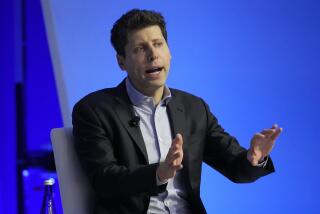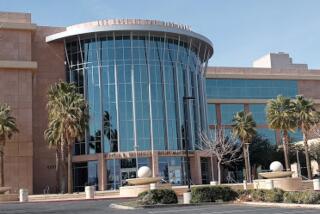Use of Tapes May Threaten Convictions
- Share via
Gregory Bristford Brackett stood accused of molesting the 9-year-old niece of his live-in girlfriend. He had his defense all ready: a dozen witnesses to back him up, a lawyer expert at parrying such charges.
And then he found a surprise ally--in a tape recorder.
In California, all defendants are entitled to have judicial proceedings recorded in shorthand by certified court reporters. But the downtown courtroom where Brackett awaited trial used an electronic recorder, not a trained stenographer, to preserve the official record.
The machine saves taxpayers money--more than $36,500 per courtroom per year, according to one court estimate. If audiotapes replaced stenographic machines in every courtroom, the cash-starved Superior Court could shave at least $9 million from its annual budget.
Yet Brackett’s lawyer was concerned not with windfalls, but with winning.
He asserted his client’s right to a court reporter. Prosecutors backed him up. They refused to proceed with the trial, fearing that Brackett successfully could appeal a conviction because technology, rather than typists, recorded the proceedings.
And so the People vs. Gregory B. Brackett became the latest victim of a nasty, long-running feud that could be dubbed the People vs. the Machines.
So far, only two cases have been dismissed outright because of the controversy. But Superior Court Judge Gregory C. O’Brien Jr., who dismissed the Brackett case last month, tallies at least 100 criminal convictions obtained in courtrooms equipped with electronic machines. If prosecutors continue to protest that such trials are vulnerable to appeal, O’Brien said, they may be undercutting their own convictions. As he put it during a hearing on the Brackett case: “If the district attorney seeks the reversal of its own cases, that would be news.”
Prosecutors insist that they are not trying to jeopardize convictions already obtained. Rather, they are hoping to protect future convictions from appeals.
The dispute’s roots stretch back a decade, to 1986, when the state Legislature granted some courts permission to experiment with electronic recording. Court reporters grudgingly assented. But they insisted on a time limit: The machines must be out by 1992. When some courts continued to use tape recorders after that deadline, the powerful court reporters association sued.
The 1st District Court of Appeal in San Francisco last year ruled in the group’s favor, proclaiming that electronic devices could not become official judicial record-keepers. Nonetheless, judges in Los Angeles are continuing to use them, insisting they are just as accurate and a heck of a lot cheaper than human stenographers.
“If the Legislature says, for example, all courtrooms are required to have a doorman . . . and we don’t have a doorman for you, that doesn’t qualitatively affect the outcome of the proceeding,” O’Brien said.
For a technical issue, the human-versus-machine debate has clearly gener
ated a lot of passion. And no wonder.
Judicial integrity may be at stake. Big money most definitely is.
Los Angeles court reporters earn up to $60,000 a year, plus benefits. The county pays them that salary to take notes during normal court hours. When the reporters go home and transform their stenographic keystrokes into legible transcripts, they are considered freelancers. And the county has to pay them extra for the work.
As the law now stands, the court owns the stenographic notes, but the court reporters own every transcript they produce. Since no one can read the stenographic symbols, court reporters effectively pocket the only viable version of public record. Then they charge everyone who wants a peek, including lawyers, county officials and journalists.
*
The county is obligated by law to provide transcripts to criminal defendants. It also foots the bill for transcripts ordered by public defenders and prosecutors. At 85 cents per 100 words for the first transcript, and up to 20 cents per 100 words for additional copies, the fees pile up fast.
“We’re paying through the nose,” said Superior Court Judge George Trammell III.
Most court reporters take in $10,000 to $15,000 a year for their transcript work. In a big case like the O.J. Simpson double murder trial, their transcript fees can far outstrip their salary.
*
The dual-payment system developed decades ago, when transcribing took at least as much time as taking notes. But today’s computer software (which court reporters must buy with their own money) instantly can translate stenographic symbols into English.
“They have created for themselves a very lucrative monopoly,” Superior Court Judge Kurt Lewin said. “To perpetuate that monopoly is a disgrace.”
With electronic systems such as tape recorders, the court--not the court reporter--owns an accessible record of each judicial proceeding. Instead of waiting for official transcripts, interested parties can buy tapes of each day’s action minutes after the court session ends. Audiotapes cost $10 each and videos, $50. That’s considerably less than the hundreds of dollars a day’s transcript usually runs.
But court reporters insist that the savings are illusory.
Although an electronic taping system might reduce upfront costs, they say, it hikes the overall expense of producing a transcript.
A public defender preparing an appeal would no longer be able to flip through a typewritten text or scan a computer disk to find citations. Instead, he or she would have to waste hours sorting through cassettes from the first trial and pulling out relevant snippets--all on county time.
*
“For the court, it may not be a losing proposition, but for the taxpayer it is,” veteran court reporter Gary Cramer said.
Plus, Cramer noted, appellate courts will accept only typed transcripts. The county couldn’t dump a box of tapes on an appeals court judge’s desk; taxpayers would have to pay for transcription service.
And since the person typing the text most likely would not have attended the court proceeding, Cramer warned, errors could compromise the integrity of the judicial record.
“With court reporters, the same person hears the words, types them and proofreads them. We certify the record,” Cramer said. Anonymous transcribers would not have the same accountability, he said. And when they came across a fuzzy spot in the tape, he added, they would tend to “hear what [they] want to hear.”
*
Because tapes pick up background noise as well as speech, court reporters say, a recording could end up sounding more like a cocktail party than a judicial proceeding, with key moments drowned out or blurred by arguing attorneys.
As Marshall Jorpeland, communications director for the National Court Reporters Assn., put it: “You can always tell when a court reporter has a heart attack . . . [But] a tape won’t tell you when it’s not getting something.”
In the most notorious machine malfunction, the tape that was supposed to contain the official record of a secret federal hearing on the Oklahoma City bombing turned out to be blank. Officials could assume only that the recorder had not been switched on.
Los Angeles judges say such bloopers are rare. They hire monitors to watch the tapes spool and jot down when key testimony is recorded. “I don’t think anyone has ever raised a case where the tape was inaccurate,” Assistant Presiding Judge Robert W. Parkin said.
In the Brackett case, neither side argued that the quality of the record would be compromised by the use of an electronic recorder. Instead, they focused on the narrow, technical issue of the defendant’s legal right to a human court reporter.
*
Such disputes have not disrupted trials in the past because most of the Superior Court’s 71 electronic recording systems are installed in civil courtrooms, where litigants tend to accept the machines. Criminal defendants, however, are not so willing to relinquish their rights--not when their lawyers sense possible grounds for appeal.
Now that “three strikes” cases have swamped criminal courts, more felony trials are spilling into civil courtrooms equipped with tape recorders. The day before dismissing the Brackett molestation case in mid-March, O’Brien let two alleged insurance bilkers go free because his court could not provide the stenographic reporter they demanded.
“As a prosecutor, it’s frustrating,” said Deputy Dist. Atty. Mark C. Kim, who has appealed the judge’s decision to dismiss the insurance swindling case.
Prosecutors already have filed fresh charges against Brackett. They re-arrested Brackett before he left the courtroom, so he never enjoyed even one minute of freedom as a result of the tape-recorder dispute.
*
Back at square one in the People vs. Gregory Brackett, prosecutors must repeat both the arraignment and the preliminary hearing--costly and time-consuming procedures. Even then, they have no guarantee the trial will land in a courtroom equipped with a stenographer.
This is a “time of crisis,” O’Brien said, “when we have 8,000 felony cases awaiting trial and not enough judges to get them tried in the criminal system, [so] the court is, therefore, moving heaven and earth to try these cases in the civil departments,” many equipped only with tape recorders.
Parkin argues that the court should be free to use any recording method that produces a reliable verbatim transcript. The judge would like to gradually replace court reporters with video cameras. Because such systems do not require a full-time monitor (judges can see the video feed from the bench and spot problems on their own), videos are even cheaper than audio tapes.
Parkin estimates that the Superior Court could save more than $20 million a year by switching entirely to video.
Yet veteran court reporter Katy Ingersoll scoffed at the idea that cheap audio and video systems could threaten her job. “I just would not worry about it,” she said firmly.
Lewin responds to such insouciance with a warning. Court reporters who refuse to adapt to the new, cost-conscious times, he said, will end up “just like the people who made buggywhips when Henry Ford came along.”
Times staff writer Josh Meyer contributed to this report.
More to Read
Sign up for Essential California
The most important California stories and recommendations in your inbox every morning.
You may occasionally receive promotional content from the Los Angeles Times.













